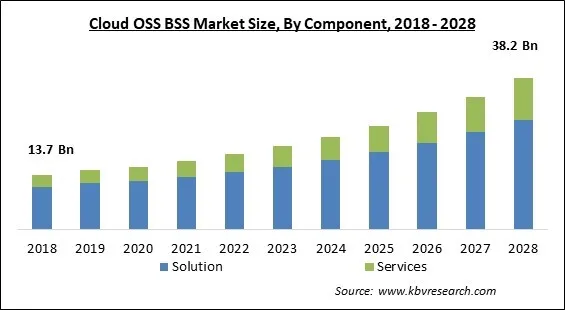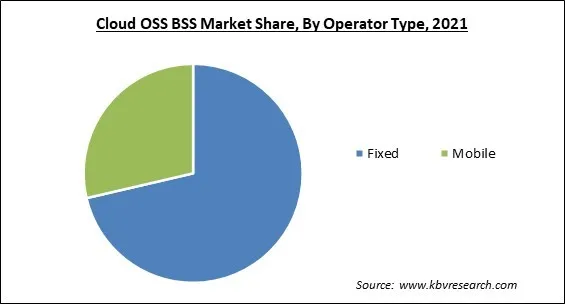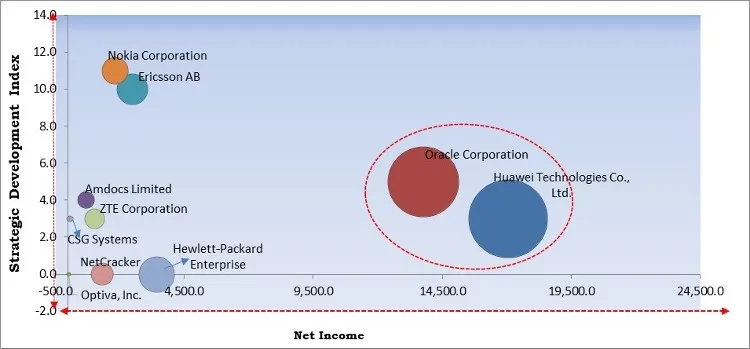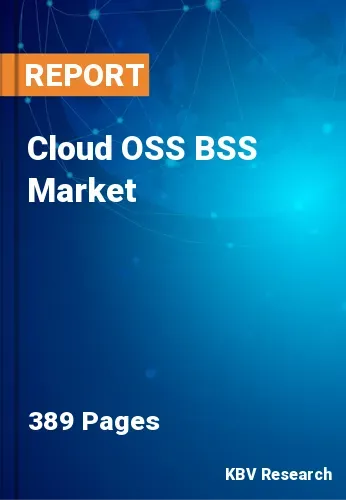The Global Cloud OSS BSS Market size is expected to reach $38.2 billion by 2028, rising at a market growth of 12.4% CAGR during the forecast period.
The terms operations support system (OSS) and business support system (BSS) are used interchangeably in the telecommunications industry. The distinction stresses the layer of abstraction between network operations and the company that is formed around the network. With their OSS/BSS, communications service providers support a wide range of services and functions. Order capture, Customer Relationship Management, and Telecommunications billing are the primary functions of BSS, whereas Order Processing, Network Inventory Control, and Network Operations are the primary functions of OSS.
CSPs (Communication Service Providers) are at a crossroads. Self-service, customized, and Omni channel experiences are what their customers expect. This necessitates CSPs to transform their complete service distribution and administration architecture on three fronts: network service management, operations support systems (OSS), and customer and overall company operations management - the business support systems (BSS). OSS and BSS have long been important software building blocks in the telecom sector.
They are logical structures that represent a telecom and network management system. Order Management, CRM, Billing, Network Operations, Service Management System, Provisioning, Account System, and Customer Service System are just a few of the functional blocks they have. As networks migrate to IP and business connections and standards shift, OSS and BSS are becoming more important than ever. The operator requires an agile OSS/BSS solution in the new telecom era, with innovative service layer infrastructure and consumer experience administration at its core, resulting in a shift to network as a service, where the operator can provide customized solutions and individualized customer experiences.

COVID-19 is an international public health crisis that has impacted practically every business, and its long-term impacts on industry growth over the forecast period. The research examines COVID-19 in light of changes in consumer behavior and desire, purchasing patterns, supply chain re-routing, market dynamics, and government involvement. COVID-19's impact on the market is examined in this revised report, which includes insights, analyses, estimates, and forecasts. The COVID-19 pandemic has wreaked havoc on people's daily lives, their workplaces, and their surroundings.
The telecom business provides a wide range of support services, including networking, customer profile management, and numerous billing management methods, all of which are connected with operating costs. CSPs can benefit from the cloud since it offers them a comprehensive IT infrastructure at a cheaper cost, allowing them to improve their overall operations. Using the various resource tracking technologies, CSPs always strive to maintain track of OPEX. Telecom service providers were facing challenges to cut operational expenses as new technologies emerged at a rapid rate.
Networking assets, both real and virtualized, are today distributed among multiple vendors and locations in various companies. Manually maintaining such a rapidly increasing estate is no longer an option. It's difficult to distinguish crucial performance and security events from the daily clutter of unprocessed raw log messages, alarms from edge devices, as well as other connected hardware. Enterprise would need to unify reporting streams to get end-to-end insight in such complex environments.
The single biggest impediment to BSS deployment in the public cloud was highlighted as data security and privacy security rules and regulations. Many of the Admins found struggling to figure out exactly what they were allowed and not allowed to do with their customers' data because new legislation is typically complicated. Companies wanted to purchase a bigger cloud-based system for computing sales commission payments but wasn't sure if it was allowed since the sales commission data contained some customer data. Administrators aren't used to or comfortable with having to think about security, regulatory, or financial challenges in addition to IT.

On the basis of component, the Cloud OSS BSS market is divided into solution and services. The service segment witnessed a substantial revenue share in the in the Cloud OSS BSS market in 2021. Cloud OSS and BSS service providers enable telecom firms to focus on their core strengths and provide effective services to their end-users by integrating solutions such as order management, revenue management, product management, and associated subcomponents.
On the basis of cloud, the Cloud OSS BSS market is categorized into Public, private, and Hybrid Public. The public segment procured the highest revenue share in the Cloud OSS BSS market in 2021. The public cloud can be scaled indefinitely without trial. As a result, there's no need to generate future workload forecasts or overprovision resources right now. Consumers essentially pay for the server infrastructure demand right now, and the application hosting fees would adjust appropriately if requirements change in the future. Physical servers are used by public cloud providers, and there are a lot of them.
Based on the Organization type, Cloud OSS BSS market is fragmented into Large enterprise and Small & Medium Enterprises (SMEs). The small & medium enterprises recorded a significant revenue share in the Cloud OSS BSS market in 2021. The open-source software declaration of freedom protects consumers by providing transparency, whereas the public nature of the source code allows other developers to easily copy anything that is removed. Any firm that wishes to reach its full potential must invest in the correct software solutions to achieve maximum productivity, cost-efficiency, and uniformity throughout the organization.
Based on the operator, the Cloud OSS BSS market is divided into mobile operator and fixed operator Mobile operator. The fixed segment acquired the largest revenue share in the Cloud OSS BSS market in 2021. An airport grants a fixed-base operator the right to operate at the airport and provide aeronautical services such refueling, aircraft rental, wrap and parking, flight instruction, aircraft repair, and related services.
| Report Attribute | Details |
|---|---|
| Market size value in 2021 | USD 17.2 Billion |
| Market size forecast in 2028 | USD 38.2 Billion |
| Base Year | 2021 |
| Historical Period | 2018 to 2020 |
| Forecast Period | 2022 to 2028 |
| Revenue Growth Rate | CAGR of 12.4% from 2022 to 2028 |
| Number of Pages | 385 |
| Number of Tables | 693 |
| Report coverage | Market Trends, Revenue Estimation and Forecast, Segmentation Analysis, Regional and Country Breakdown, Competitive Landscape, Companies Strategic Developments, Company Profiling |
| Segments covered | Component, Cloud Type, Operator Type, Organization Size, Region |
| Country scope | US, Canada, Mexico, Germany, UK, France, Russia, Spain, Italy, China, Japan, India, South Korea, Singapore, Malaysia, Brazil, Argentina, UAE, Saudi Arabia, South Africa, Nigeria |
| Growth Drivers |
|
| Restraints |
|
By Region, the Cloud OSS BSS Market is analyzed across North America, Europe, APAC, and LAMEA. The Asia pacific region acquired a significant revenue share in Cloud OSS BSS market in 2021. Rapid economic development, globalization, FDI, cloud-based solutions, network ecosystem developments, and widespread adoption of smartphones and the internet among consumers and enterprises would all contribute to the growth of the cloud OSS BSS market in the Asia Pacific region. Furthermore, the region's large population has resulted in a large customer base for telecom firms that would drive the business in the region.
Free Valuable Insights: Global Cloud OSS BSS Market size to reach USD 38.2 Billion by 2028

The major strategies followed by the market participants are Product Launches. Based on the Analysis presented in the Cardinal matrix; Oracle Corporation and Huawei Technologies Co., Ltd. are the forerunners in the Cloud OSS BSS Market. The Oracle Cloud allows telecommunications companies to become more nimble, minimize capital consumption and working price, and authorize a flexible foundation for innovation.
The market research report covers the analysis of key stake holders of the market. Key companies profiled in the report include Oracle Corporation, Nokia Corporation, Ericsson AB, NetCracker Technology Corporation (NEC Corporation), Optiva, Inc., ZTE Corporation, Hewlett-Packard Enterprise Company, Huawei Technologies Co., Ltd. (Huawei Investment & Holding Co., Ltd.), and Amdocs Limited.
By Component
By Cloud Type
By Organization Size
By Operator Type
By Geography


The global cloud OSS BSS market size is expected to reach $265.9 billion by 2028.
High end visibility in the OSS module are driving the market in coming years, however, privacy, security, and upkeep costs of the cloud OSS BSS growth of the market.
Oracle Corporation, Nokia Corporation, Ericsson AB, NetCracker Technology Corporation (NEC Corporation), Optiva, Inc., ZTE Corporation, Hewlett-Packard Enterprise Company, Huawei Technologies Co., Ltd. (Huawei Investment & Holding Co., Ltd.), and Amdocs Limited.
The Solution segment acquired maximum revenue share in the Global Cloud OSS BSS Market by Component in 2021, thereby, achieving a market value of $27.6 billion by 2028.
The Large Enterprises segment is leading the Global Cloud OSS BSS Market by Organization Size in 2021, thereby, achieving a market value of $23.6 billion by 2028.
The North America market dominated the Global Cloud OSS BSS Market by Region in 2021, and would continue to be a dominant market till 2028.
Our team of dedicated experts can provide you with attractive expansion opportunities for your business.

